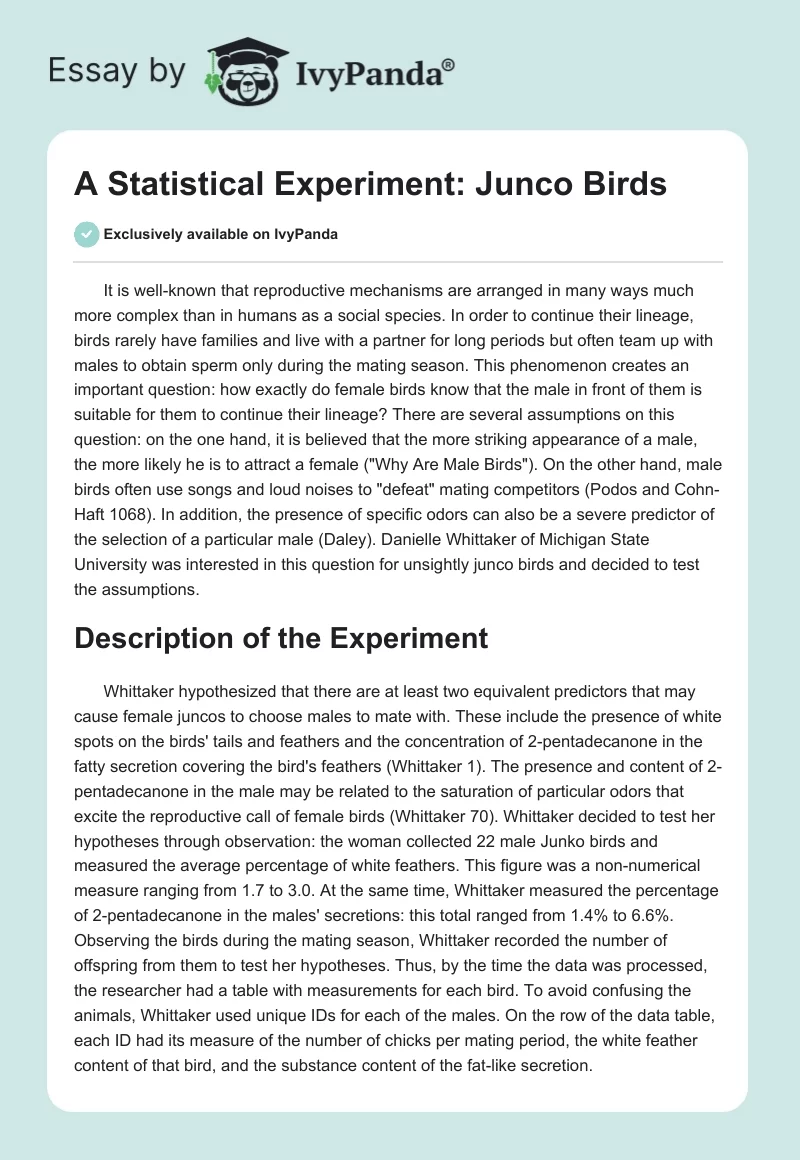It is well-known that reproductive mechanisms are arranged in many ways much more complex than in humans as a social species. In order to continue their lineage, birds rarely have families and live with a partner for long periods but often team up with males to obtain sperm only during the mating season. This phenomenon creates an important question: how exactly do female birds know that the male in front of them is suitable for them to continue their lineage? There are several assumptions on this question: on the one hand, it is believed that the more striking appearance of a male, the more likely he is to attract a female (“Why Are Male Birds”). On the other hand, male birds often use songs and loud noises to “defeat” mating competitors (Podos and Cohn-Haft 1068). In addition, the presence of specific odors can also be a severe predictor of the selection of a particular male (Daley). Danielle Whittaker of Michigan State University was interested in this question for unsightly junco birds and decided to test the assumptions.
Description of the Experiment
Whittaker hypothesized that there are at least two equivalent predictors that may cause female juncos to choose males to mate with. These include the presence of white spots on the birds’ tails and feathers and the concentration of 2-pentadecanone in the fatty secretion covering the bird’s feathers (Whittaker 1). The presence and content of 2-pentadecanone in the male may be related to the saturation of particular odors that excite the reproductive call of female birds (Whittaker 70). Whittaker decided to test her hypotheses through observation: the woman collected 22 male Junko birds and measured the average percentage of white feathers. This figure was a non-numerical measure ranging from 1.7 to 3.0. At the same time, Whittaker measured the percentage of 2-pentadecanone in the males’ secretions: this total ranged from 1.4% to 6.6%. Observing the birds during the mating season, Whittaker recorded the number of offspring from them to test her hypotheses. Thus, by the time the data was processed, the researcher had a table with measurements for each bird. To avoid confusing the animals, Whittaker used unique IDs for each of the males. On the row of the data table, each ID had its measure of the number of chicks per mating period, the white feather content of that bird, and the substance content of the fat-like secretion.
Research Question
Do the percentage of 2-pentadecanone in the fat-like secretion and the number of white feathers in male juncos affect their attractiveness among females during the mating period?
Hypotheses
- The greater the number of white spots characteristic of a male junco, the more likely it was that a female would choose him.
- The more significant the percentage of 2-pentadecanone contained in the fatty secretion of male juncos, the more likely it was that the female would choose him.
Variables
There were two independent variables and one dependent variable in this trial. The independent variables were 2-pentadecanone content and the proportion of white feathers in the male. Both of these variables seemed to influence the dependent variable, which was the number of offspring from that bird during the mating period. More specifically, changes in 2-pentadecanone content and the proportion of white feathers may have changed the number of offspring from this male. The accuracy of this relationship has yet to be elucidated by correlation and regression analyses, which is part of the next steps of the study (Calvello). This will allow us to know the degree, strength, and direction of the relationship between the variables.
Works Cited
Calvello, Mara. “Correlation vs. Regression Made Easy: Which to Use + Why”. G2, 2020, Web.
Daley, Jason. “Birds Sniff Each Other’s Bacteria to Help Choose a Mate”. Smithsonian, 2019, Web.
Podos, Jeffrey, and Mario Cohn-Haft. “Extremely Loud Mating Songs at Close Range in White Bellbirds.” Current Biology, vol. 29, no. 20, 2019, pp. 1068-1069.
Whittaker, Danielle. “Sexy Smells”. Data Nugget, 2021. Web.
“Why Are Male Birds More Colorful Than Female Birds?” Lyric, 2020, Web.
Whittaker, Danielle J., et al. “Chemical Profiles Reflect Heterozygosity and Seasonality in a Tropical Lekking Passerine Bird.” Animal Behaviour, vol. 151, 2019, pp. 67-75.


